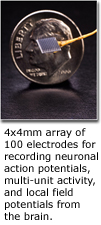Thought Controlled Robot Arm
Recently a woman who has been paralyzed for 15 years after a stroke was able to control a robotic arm with just her thoughts and take a sip of coffee. Something she had not been able to do since having a stroke that caused her paralysis. This achievement was done with a prosthetic designed robot arm and a sensor called BrainGate which implanted in the brain.
Brain Controlled History
The ability to control computers and devices with your brain is a developing science that has made great achievements in the last few years. The first breakthroughs came with being able to control a cursor or other object on a computer screen. Then being able to do more complicated tasks on a computer screen like playing simple video games. Now the next step is moving away from the 2D environment of a computer screen and being able to move objects in three dimensions.
Brain to Robot
Tasks of controlling a robotic arm begins with transmitting the brain signals. This begins with the BrainGate System. Here a small sensor is implanted onto the surface of the brain. This sensor takes in the brain signals and translates them to a computer which then tells the robot arm what to do. The current experiments were done with two patients and two different robotic arms. Tasks began with getting the arm to touch certain objects as they pop up. Eventually leading to being able to control the arm to pick up a coffee cup, tilt it, and take a drink.

Future of Brain Control
Besides the robotic arm, there is also experimentation on thought controlled electric wheelchairs. Eventually the goal is to be able to control other devices with your thoughts. Such as turning on TVs and computers to controlling kitchen appliances.
Participation and Tech Info
If you live near Boston, MA and or Palo Alto, CA, you might be able to participate in clinical trials. If interested follow this link. This technology is way beyond my own brain capacity so to read more about how this works follow these links on Nature and BrainGate.
